5 Crop and Livestock Charts to Ponder from USDA’s 10-Year Outlook
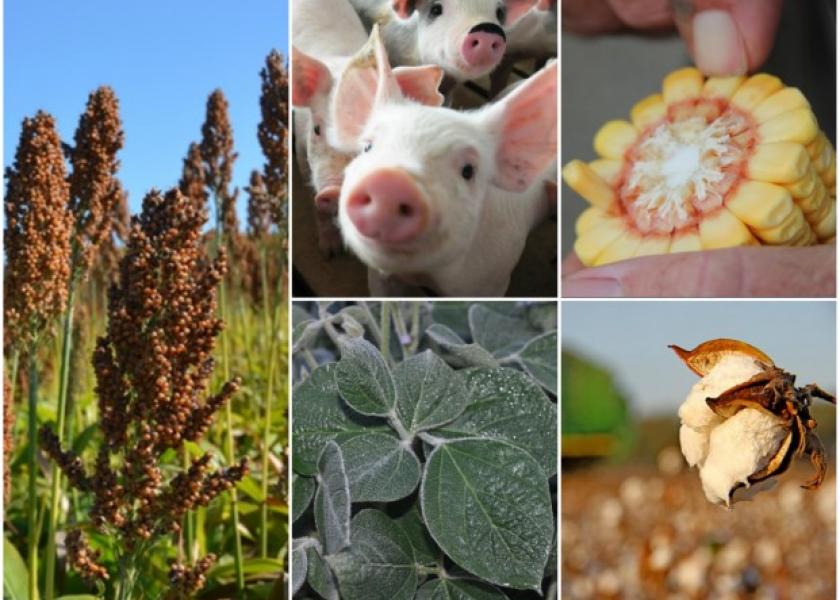
What will the next decade hold for your farm? What factors should you use to weigh investments or crop planning?
Each year USDA provides a 10-year outlook for major crop and livestock commodities. Known as the Agricultural Baseline Projections, this report guides agricultural investments in Washington, D.C., and is helpful for farmers as it shines a light on current and future trends.
The latest baselined is built on the years 2023/24 to 2032/33. Here are five trends and data sets to ponder.
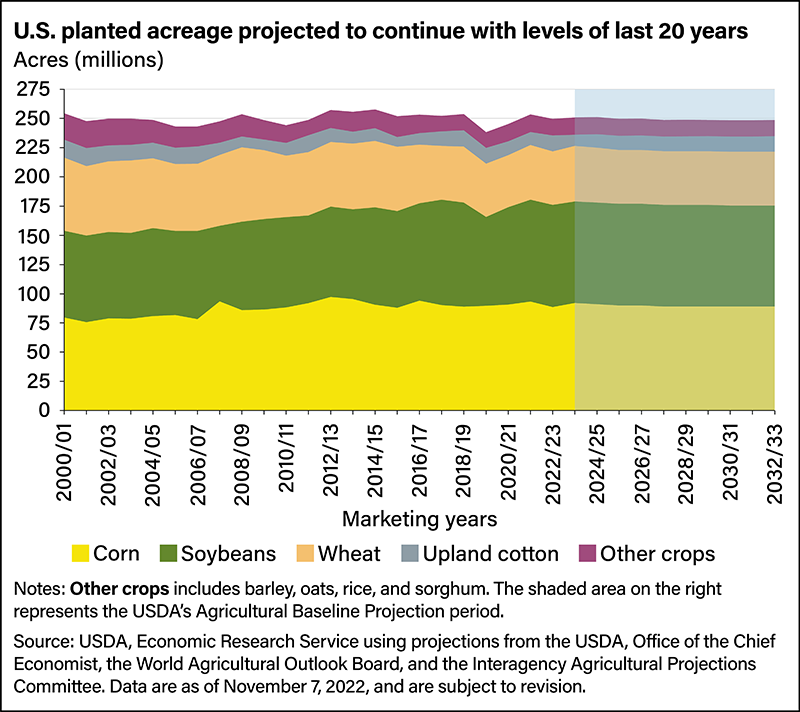
U.S. Crop Acres Stay Steady
High commodity prices typically expand total planted acres for the eight major field crops (barley, corn, cotton, oats, rice, sorghum, soybeans, and wheat). But total acres dipped to 249.5 million in 2022/23 from 253.4 million in 2021/22 largely because weather prevented plantings last crop season.
Did You Know? Corn, soybeans, wheat and upland cotton comprised more than 94% of the eight-crop total in 2022/23.
For 2023/24, USDA projects corn acres to rise by 3.4 million to 92 million. In a decade, USDA predicts corn acres to taper down to 89 million.
For soybeans, acres this year are projected at 87 million. By 2023/24, soybean acres are projected to be 86.5 million.
For wheat, acres are projected to jump 4% and hit 47.5 million this year. In the next decade, USDA projects wheat acres to decline to 46 million.
Cotton acres are expected to drop to 9.5 million in 2023/24, down from 13.6 million in 2022/23 (and among the lowest since 1960).
Higher yields are expected to more than compensate for reduced planted acreage, resulting in record-high production for corn and soybeans and increased wheat production.
The national average corn yield is projected at 181.5 bu. per acre in 2023/24, up from 171.9 bu. in 2022/23, when drought zapped yields.
Did You Know? USDA projects the national average corn yield to hit just under 200 bu. by 2032/33.
Soybean yields are expected to recover from a four-year low of 49.8 bu. per acre in 2022/23. For this season, soybean yields are expected to average 52 bu. per acre and hit 56.5 bu. by 2032/33.
Wheat yields are expected to return to more typical levels this year — 49.2 bu. per acre, and to continue rising through the projection period, ending at 52.7 bushels per acre in 2032/33.
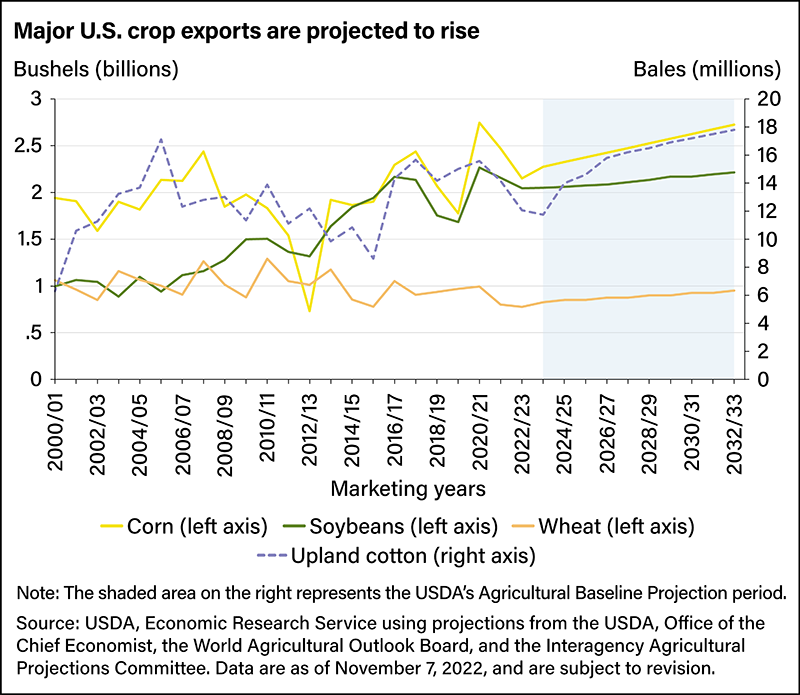
Domestic and International Crop Demand Are Expected to Grow
In the next decade, domestic demand for corn, soybeans, wheat, and cotton are all expected to grow over the next decade. Also, exports of the four crops are expected to increase over the next decade, reaching record highs for upland cotton and near record levels for corn and soybeans.
Corn:
- Driven by growth in pork, chicken and beef sectors, domestic corn use is expected to grow from 12.5 billion bushels in 2023/24 to 13.4 billion bushels by 2032/33. Use of corn for food, seed and in industrial applications, including ethanol, is projected to decline slightly over the same period.
- U.S. corn exports are expected to rise nearly 20% from 2023/24 to 2032/33, ending at 2.7 billion bushels, which would be the second-highest corn export volume on record.
Soybeans
- Soybean crush is expected to rise from 2.3 billion bushels in 2023/24 to 2.5 billion bushels in 2032/33.
- Soybean exports are expected to rise 8% over the projection period.
Wheat
- Domestic use of wheat is projected to remain relatively steady, rising 2.4% through 2032/33.
- U.S. wheat exports are projected to jump 15% in the next decade.

Crop Prices Go Down, then Stabilize
After hitting near-record highs last year, corn, soybean and wheat prices are all expected to decline in the short term.
Corn prices are expected to drift down to $5.70 per bushel this year and continue drifting down before stabilizing at $4.30.
Soybean prices follow a similar trend, falling to $13 a bushel this year and continue dropping until prices stabilize at around $10.30 per bushel.
Wheat prices are expected to drop from a record $9.20 a bushel in 2022/23 to $8 in 2023/24. By 2032/33, prices are projected to settle near $5.70 per bushel.
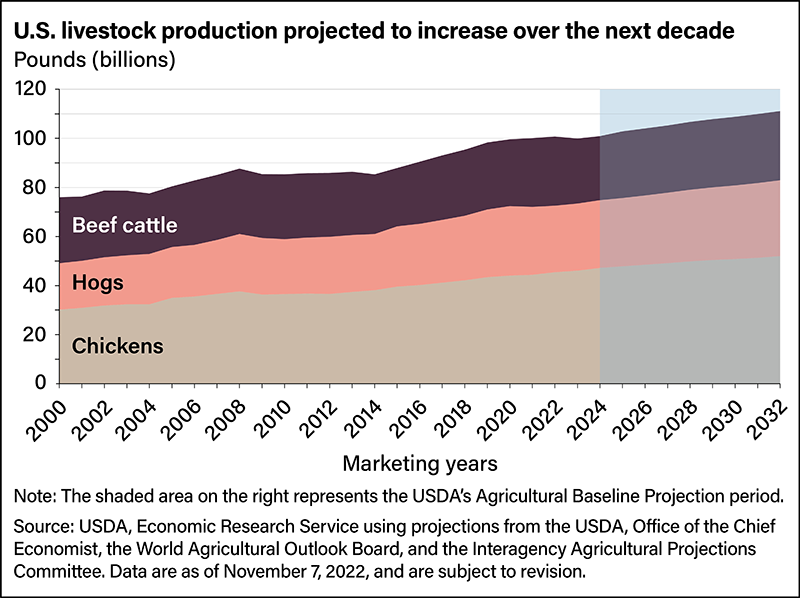
Livestock Production Set to Expand
Beef production is projected to grow through 2032, after contracting in 2023 and 2024. Commercial slaughter volumes and weights are expected to increase, expanding production to record levels by 2032. Beginning at 26 billion pounds in 2024, production is estimated to grow to 28.1 billion pounds in 2032.
Pork production is also projected to increase over the 10-year projection period, driven by rising hog inventories as producers increase supply to meet processor demand. Total commercial production of pork is projected to grow from 27.6 billion pounds in 2024 to a record 30.9 billion pounds in 2032 — a 12% increase.
Chicken production is expected to follow a similar pattern, growing 10% over the projection period to a record 52 billion pounds in 2032.
Did You Know? The U.S. sends a surplus of higher value cuts of feedlot-finished beef to Europe and Asia and imports lower value lean beef to supplement the domestic production of ground beef.
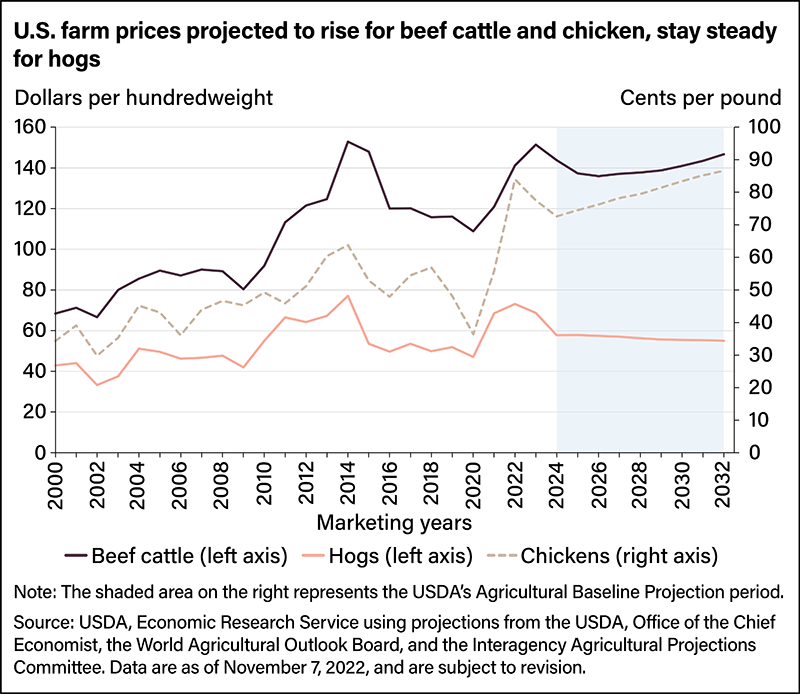
A Mixed Bag for Livestock Prices
In the near term, farm prices for all animals and animal products are projected to fall from recent record or near-record levels set in 2022.
- Cattle: After an initial decline, cattle prices are expected to rise steadily after 2026.
- Pork: Hog prices are expected to decline through most of the projection period, with the farm price for hogs in 2032 almost 5% lower than in 2024.
- Chicken: By the end of the projection period, chicken prices are expected to approach record levels, with farm prices for broilers (young chickens) rising 19%.







